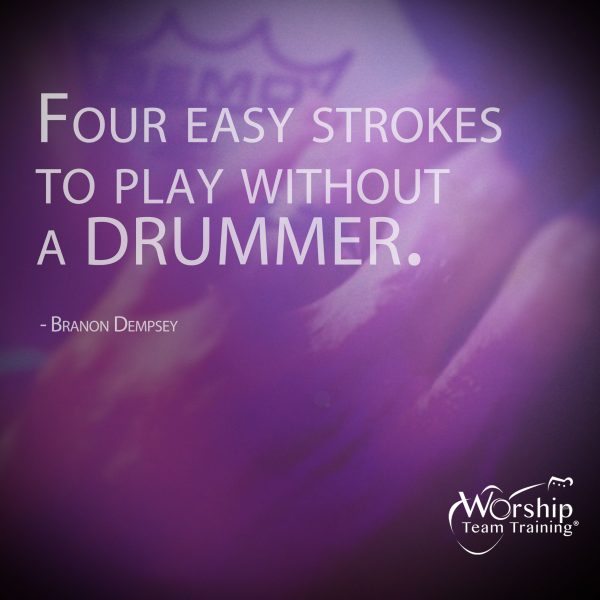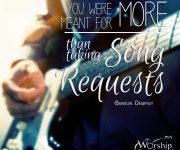Guitar, Players
Can’t Keep a Beat
 Can’t Keep a Beat? Bet Your Guitarist Can.
Can’t Keep a Beat? Bet Your Guitarist Can.
Four easy strokes to play without a drummer Ok, you’re on deck this week to lead worship. You get the dreaded call. How many of you cringe from the phone call, when your only drummer says “sorry dude, I can’t be there on Sunday.”?
Well, maybe next time you can tell ‘em “Have a nice trip!” Just kidding 😉 all you drummers out there (you too Carl!). Any dedicated drummer will tell you that good timing is essential for great playing.
Here are four easy strokes to help you kick the drummer blues:
1. Do not use a drum machine. Turn it into a quazi-acoustic Service. At our WTT Workshops, we have seen and work with a lot of bands. Unfortunately, not many know what to do without the drummer. Don’t try your regular worship set with all electric guitars and keyboards. Without a drummer in the band, it’s like trying to drive a car on 3 wheels. With a few new tricks, you can bring a fresh energy to your next worship service.
2. Pick songs that are not drummer dependent. Easy songs that can be held together by few instrument is better. Songs like “Set A Fire,” “Hosanna,” and “Everlasting God” are simple enough without drums. I would steer clear of using “Go,” or “Sing, Sing, Sing” that require more drum aptitude. You don’t have to have songs that require great drums in order to have great worship.
3. In having two guitar players, one can be the rhythm and the other the rhyme. Let one strum quarters or mute eight notes, while the second player capos or picks out the notes of the chords. Playing a counterpart rhythm is helpful as long as it’s simple and easy. A rule of thumb is to keep it simple, clear and timed.
If you have piano and bass in the mix, let them play off of the rhythm guitar player as they would a drummer. It simply requires a lot of listening and less lot less of doing. You gotta keep in mind that the goal is what the overall sound your band can achieve, not just by the individual parts.
4. Here’s the big one: Texture and technique by the use of palm muting and strumming.
If you’re playing acoustic, you need to be thinking like a drummer. This involve playing textures such as palm muting, string muting and accents. Muting the strings and adding accents will help create groove as opposed to just open strumming that can induce a congregational coma.
Palm muting involves cupping your strumming hand just over the strings and sound hole and/or midway to the bridge. As soon as after you play and open strum, cup your hand over the strings to stop the vibration. It will almost act like two cymbals coming together to choke, much like the action of a hi-hat. You can actually simulate a kick drum pattern for this technique.
Try a pattern where you have a combination of open strums and muted notes. This technique is used in a lot of folk and southern rock, like the Eagles, James Taylor and Eric Clapton. For another texture and technique, try muting the strings while playing at the same time. This technique is a true art to manage pure tone and timing, while keeping all the rhythms smooth and equal volume from note to note.
Simply, use the back of your palm to touch lightly on the strings over the sound hole. As you dampen the strings with your palm, use a pick (or fingers) to strum the top one or two strings of the chord. You should get a “chuck” sound as the strings do not vibrate, but rather stop immediately after the strike.
Think of this as playing 8th notes on a closed hi-hat for the same effect. This action actually turns your guitar into more of a percussive instrument. Practice by playing 8th notes in the strumming hand, while forming an G, E or A (or barre) chords in the other hand. This very familiar sound is heard from Johnny Cash, U2 and John Mayer. Lastly, using accents over muting or strumming parts add nice effects to the notes.
You can use them interchangeably to simulate a snare drum. Practice these techniques at 80bpm moving to about 125bpm. For instance, play your 8th note muted pattern in 4/4 time, and accent your strums on 2 and 4 – this gives it more of a pop or rock sound.
Try it the opposite (a bit more challenging), strum 8th notes and palm mute the strings on 2 and 4 – this gives it more of a country or Eagles feel. Finally, try a strumming pattern involving all open strings at a lower dynamic soft level.
Accent on different beats using a forte level – same pattern on 2 and 4 or use another variation. While you’re playing this texture, have your second guitarist arpeggiate the chord or play another complimentary rhythm. You have the ability to create beautiful combinations. Now you can play without a drummer! It’s all about working with what you have, and not to throw in the towel (or the stick).
Besides, when your drummer returns, you’ve had the opportunity to really tighten up the guitar section. Overall, the rhythm section will have some new tools to inspire, textures to create and grooves to help transform your next worship service. Happy pickin’ and grinnin’!
 Worship Team Training® Is your worship team stuck? Want worship leading to be better? Want to be free? We can take you there. Inspire, create and transform the leading of worship. Get a WeekendWorkshop
Worship Team Training® Is your worship team stuck? Want worship leading to be better? Want to be free? We can take you there. Inspire, create and transform the leading of worship. Get a WeekendWorkshopCopyright 2017 Worship Team Training®









